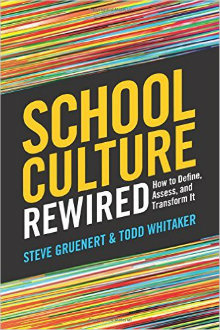How to Build a Vibrant School Culture
School Culture Rewired: How to Define, Assess, and Transform It
By Steve Gruenert & Todd Whitaker
(ASCD, 2015 – Learn more)

School culture can be a very complex and intimidating component of any school system or building. Yet it’s imperative that education leaders develop an awareness of the culture around them and the impact that culture has on actions and attitudes.
The topic of school culture has been of particular interest to me throughout my first few years in administration. What is the impact school culture is having in my building? How do I identify the roots of the culture? And, if needed, how do I attempt to steer the parts of the culture in a different direction?

School Culture Rewired does a tremendous job of guiding leaders through the process of defining, assessing, and transforming school culture. The first part of the book helps readers develop a better understanding of school culture, including the impact of climate, which they define as “a window into culture.”
Gruenert and Whitaker also provide simple, applicable strategies to help build a culture by improving climate – including celebrating Mondays, praising and complimenting risk-taking, and having fun in meetings.
There was one particular line early in the book that resonated more than any other:
The culture of any organization is shaped by the worst behavior the leader is willing to tolerate.”
Wow! This particular quote generated a great deal of reflection for me. What message am I sending to staff when I ignore a particular behavior and what is the level of impact on the school culture?
Tools to help assess culture
The means to identify and assess school culture are found in the various surveys Gruenert and Whitaker provide in the book. The first survey is designed to help schools determine what kind of culture they really have, ranging from collaborative to toxic. As the ideal school culture is one that is collaborative, the second survey is designed to get a sense of just how much collaboration is actually present in the school. There are more surveys provided; each is unique in my experience and designed to create a stronger, more desired, school culture.
It is important to note that any transformation must be handled delicately. For each of the surveys, the authors provide details on how to administer them, what to say, what not to say, and what discussions need to take place.
What are some possible stumbling blocks to transforming a culture? What decisions can a leader make to help move a culture in a desired direction? What opportunities are there throughout the year to help transform a culture and how can these opportunities be used as leverage? Who can help in transforming a culture? These are all questions the authors answer thoroughly and in detail.
School culture cannot be taken lightly and must be understood for any school to have a tremendously positive impact on the students they serve. Just as important, it is critical that a school develops a culture that not only helps to retain its best teachers but also attract new, high quality talent.
Gruenert and Whitaker do a phenomenal job of taking the reader on a guided journey to define, assess, and transform a school culture. School Culture Rewired a must-read for any educational leader!
Doug Dunn is entering his 4th year as elementary principal and Title 1 coordinator for the North Pemiscot School District in southeast Missouri. He holds degrees from Missouri State University and William Woods University and is completing his specialist degree from Arkansas State University. His teaching experience includes math, language arts, reading, social studies, and business technology across grades 5-12. Doug can be found on Twitter and Voxer by searching for @PrincipalDunn.

































